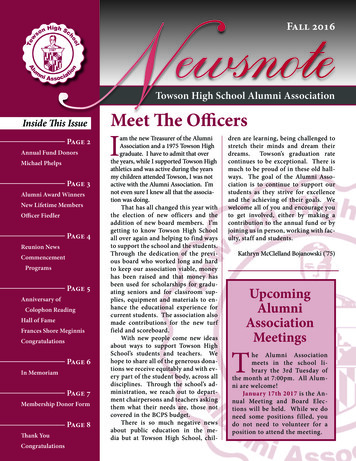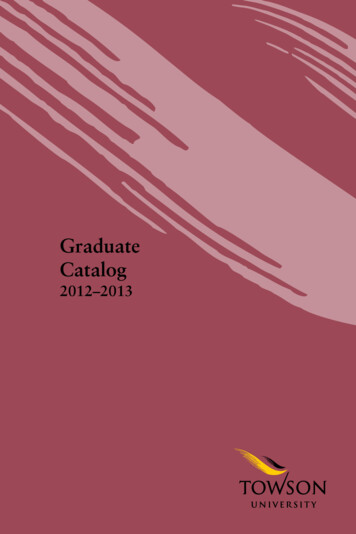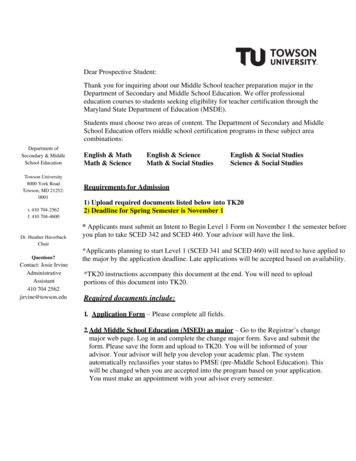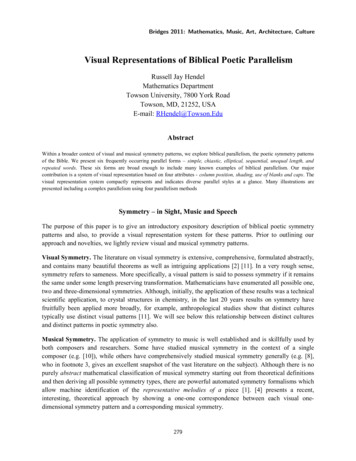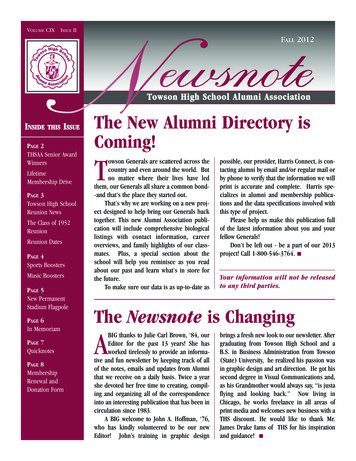
Transcription
CURRICULUMSPRING 2020ARTS & CULTURETHE SYMPHONIES OF BEETHOVENJonathan PalevskyAMERICAN JAZZ ROYALTY:Duke Ellington and Count BasieSeth KibelSessions I and IITuesday, 9:30 a.m. (begins on March 3)Fee: 130 ( 65 for each session)Sessions I and IIMonday, 11:00 a.m. (begins on March 2)Fee: 130 ( 65 for each session)There are certain groups of pieces that are a canon unto themselves and you can find no better example than the nine symphonies of Ludwig Van Beethoven. He wrote these pieces overa period of 24 years. The degree of change and developmentcontained in these masterpieces is remarkable. In 1802 Beethoven realized that his hearing was deteriorating and this radicallychanged his approach to composition and frankly everything else.While the first two symphonies are firmly ensconced in the classical tradition, the third is a musical revolution. From this pointon Beethoven realized that every symphony would be a uniquestatement of its own. The fifth is all about conflict, the sixth aboutpastoral beauty, and the seventh explores our need to dance. Hiseighth symphony is all about humor and finally the ninth containsBeethoven’s recipe for how we can all live together peacefully.While Beethoven uses forms and structures of the classicalperiod there is nothing dry or dull about one minute of his music.He was a passionate and intense individual who put every ounceof his soul and energy into these nine pieces. Even 250 years afterhis birth, they are more interesting and relevant than ever.This course is a thorough examination of the lives, careers, andmusic of two of the greatest bandleaders of jazz and swing.They had much in common as individuals, yet their music wasmarkedly different. Together, “The Duke” and “The Count” sitat the pinnacle of the American royal family of jazz. Recordings,video excerpts, and live performances from the instructor willkeep these lectures lively and interesting.Seth Kibel is one of the mid-Atlantic’s premier woodwindspecialists, working with some of the best bands in klezmer,jazz, swing, and more. Wowing audiences on saxophone,clarinet, and flute, Seth has made a name for himself in theWashington/Baltimore region, and beyond. He is the featuredperformer with The Alexandria Kleztet, Bay Jazz Project, MusicPilgrimTrio, The Natty Beaux, and more. Winner of 28 Washington Area Music Awards (Wammies), including “Best WorldMusic Instrumentalist” (2003–11) and “Best Jazz Instrumentalist” (2005, 2007–8, 2011–14).Jonathan Palevsky, B.M., M.M., is program director for WBJC.His undergraduate studies focused on musicology and hisgraduate work at Baltimore’s Peabody Institute on instrumentaltraining in classical guitar performance. Jonathan can be heardas host of Face the Music, Past Masters, WBJC Opera Fest andregular afternoon classical programming on WBJC. He alsohosts Cinema Sundays at the Charles Theater. Jonathan hasbeen a regular of the Osher faculty since the former AuburnSociety’s first semester in spring 1999.CATALOG OF SPRING 2020 COURSES5
ARTS & CULTUREGREAT AMERICAN SONGBOOK:The Art of InterpretationJulie KurzavaEIGHT PLAYS EVERYONE SHOULD KNOWGreg JonesSession IThursday, 11:00 a.m. (begins on March 5)Fee: 65Sessions I and IIMonday, 1:00 p.m. (begins on March 2)Fee: 130 ( 65 for each session)A song becomes a “standard” by remaining popular well after itsoriginal performance, encouraging other performers to createtheir own interpretations. Countless jazz and popular singershave covered standards from the Great American Songbook,such as Frank Sinatra, Ella Fitzgerald, and Tony Bennett, as wellas contemporary performers. Tone, phrasing, tempo, and orchestral arrangement are just some of the choices that a performermust make to create their version of a song. Julie Kurzava sharesher perspective as a performer and voice teacher, detailingvarious ways noted performers have used their instrument andaesthetic to make a song their own. By listening to differentperformances of well-known songs, the class will dig into thedetails of how each performer assembled their performance. Atthe end of each class, each person should understand a little bitmore about their own personal tastes and preferences.Using video clips, live performances by guests and spiriteddiscussion, this course examines why each of these plays remainsrelevant to today’s audiences. Along the way, the class discoverscommon bonds between each work that help deepen our understanding of how they continue to entertain, provoke and intrigueus. Pre-reading or screening is helpful, but not required. All playsare readily available, either on the web or through local publiclibraries. The plays to be covered are: Oedipus the King, Deathof a Salesman, Everyman, A Midsummer Night’s Dream, Tartuffe,The Cherry Orchard, Pygmalion, and A Raisin in the Sun.Julie Kurzava is a versatile singer, actor and writer who hasperformed professionally throughout the mid-Atlantic, atvenues as varied as the Columbia Orchestra, Germano’s Cabaret,Olney Theatre, the Maryland Renaissance Festival, and theAnnapolis Opera. Julie is executive director of New MoonTheater, a non-profit touring theater and opera company foryoung audiences. Julie is a popular lecturer on American musical theater and the American Songbook at life-long learningcenters throughout the region, including the Peabody Conservatory Elderhostel program. She has been a faculty member atLoyola University Maryland and is a graduate of NorthwesternUniversity (B.M.) and the Peabody Conservatory (M.M.) in voiceperformance.Greg Jones received a 2017 Julie Harris Playwriting Award forhis comedy-drama All Save One. His published articles include“The Lifelong Dinner Guest of the Negro Vogue” about LangstonHughes’s theatre influences, and profiles of playwrights MarshaNorman and Paul Zindel. He holds a B.A. in drama (CatholicUniversity) and an M.A. in English (Salisbury University) andstudied cinema with William K. Everson at NYU and playwritingwith Lucas Hnath (A Doll’s House Part 2).Classes held at 7400 York Road Free, accessible parking6OSHER LIFELONG LEARNING INSTITUTE AT TOWSON UNIVERSITY
ARTS & CULTUREDANCING LADIESPatricia EnochCONTEMPORARY GLASS ARTISTSHoward CohenSession ITuesday, 11:00a.m. (begins on March 3)Fee: 65Session IMonday, 9:30 a.m. (begins on March 2)Fee: 65The female influence on dance in America changes from theearly "cuties" of Vaudeville to the sophisticated, highly traineddancers, choreographers, and directors of the 20th century.Broadway and film benefited from their achievements and theballet and modern dance fields expanded under their teachingand performing. We will explore through lecture and film/DVDsome of these remarkable women. We'll look first at the early pioneers of modern dance: Isadora Duncan, Ruth St. Denis, MarthaGraham, and the influence of the Russians and classical balletartists such as Anna Pavlova and Albertina Rasch. We then turnto the "discovery" of Agnes de Mille and the musical, "Oklahoma,"and the many ballet and modern companies directed by women:Lucia Chase with American Ballet Theatre, Martha Graham forherself and her dancers, Katherine Dunham, Hanya Holm, TwylaTharp, and many more. We'll look at the wonderful dancing ofthose women who spanned Broadway and Hollywood such asCyd Charisse and Leslie Caron and Marie Tallchief and SuzanneFarrell from the ballet world. Finally, if time permits, we reviewthe development of women choreographer/directors such asdeMille, Onna White, Twyla Tharp, and Susan Stroman, to name afew. This is a repeat of the course offered in fall 2016.Contemporary glass artists create works that mesmerize anddazzle us. In this class, we will explore the works and creativeprocess of eight prominent glass artists. These artists halefrom Australia, the Czech Republic, Italy, Sweden, and theUnited States. They create sculptures that evoke compellingnarratives—archetypal horses, faces immersed in mysteriousand otherworldly vessels, spectacularly colored depictions ofendangered parrots from Australian rainforests, adorned masksof Shaman super-entities who impart wisdom and knowledgeto indigenous peoples in Zambia, and stringed instrumentsmade of glass that could have been created thousands of yearsago. Feminist themes—women’s strengths, the public andprivate spaces they inhabit, women caught between despairand hope, and between the moment when darkness becomesinspiration—are also explored by these artists.Patricia Enoch performed on Broadway, and after joining TheAmerican Ballet Theatre Company, she toured extensively inthe U.S., Canada, North Africa, and Europe. In Baltimore, shehas performed with the Baltimore Opera Company, various TVproductions, the Peabody Chamber Ballet, the Maria MoralesSpanish Dance Company and Pas de Six Ballet Company. Locally,she has taught and choreographed at Peabody Preparatory,Maryland Ballet, Children's Dance Division of Towson University,and the Moving Company Dance Center. She lectures for ElderHostel at Peabody Institute and Osher Lifelong Learning Instituteat Towson University. Her former students are performing in concert and Broadway venues and many are now teaching dance.Howard Cohen is an active Osher member. Howard is a Fellowof the Casualty Actuarial Society who worked primarily atGEICO prior to retiring. He has taught courses on contemporary glass art for Osher at Towson University, Osher atJHU, and the Community College of Baltimore County SeniorInstitute. A collector of art glass for the past 24 years, Howardis on the board of the Art Alliance for Contemporary Glass Art.CATALOG OF SPRING 2020 COURSES7
ARTS & CULTUREAMERICAN MURALSKatharine FernstromSOCIAL REFORM THROUGH PHOTOGRAPHYSteve DemboSessions I and IIThursday, 1 p.m. (begins on March 5)Fee: 130 ( 65 for each session)Sessions I and IIWednesday, 9:30 a.m. (begins on March 4)Fee: 130 ( 65 for each session)Murals are paintings placed on culturally meaningful walls.This course on American murals discusses the lively artworkcreated during the Beaux Arts, Work Progress Administration,Mexican Mural Movement, and mid to late 20th century CivilRights Movements through today in the 21st century. Beaux Artsmurals (1890–1920) were placed in many government buildingsand asserted conservative Neoclassical ideals. They create thebackdrop against which the WPA (1930s) asserted democraticideals during the Depression, Mexican Muralism (1920s–1930s)introduced an exotic style of narrative. More recent murals areprompting lively dialogues about American history and accomplishments, global history, and important social movements suchas the Civil Rights Movement. As cities work to maintain themselves as safe, vibrant places to live, work, and play, murals havea key role in creating a welcoming and visually rich environmentfor residents and visitors alike.Jacob Riis, who documented the crowded tenements of theLower East Side of NYC, is considered the first “socially consciousphotographer.” Along with Lewis Hine and others, he providedthe photographic proof critical to the social reform movements ofthe late 19th and early 20th centuries. They laid the groundworkfor those who followed: the photographers of the Farm SecurityAdministration—including Walker Evans, Dorothea Lange, GordonParks, and many other New Deal image makers—and photographers of the civil rights movement. We will also take a look atmore contemporary photographers including W. Eugene Smith,Sebastião Salgado and others.Katharine Fernstrom is an anthropologist and archaeologistwho teaches part-time at Towson University in the areas ofanthropology and art history. She enjoys working with muralsand their social context because murals including rock art havebeen made for at least 15,000 years in some parts of the worldand are found on every continent except Antarctica. They represent a rare opportunity to look at one art form cross-culturallyaround the world and through time.8OSHER LIFELONG LEARNING INSTITUTE AT TOWSON UNIVERSITYSteve Dembo received his M.F.A. from MICA. He is an adjunctprofessor at CCBC, where he teaches digital photography, digital imaging, and 2-D design. His photographic work has beencritically acclaimed, has garnered numerous competitive awardsand accolades, and has appeared in national publications andjuried exhibitions. He has taught several courses at the OsherLifelong Learning Institute at Towson University.
ARTS & CULTUREARTISTS OF THE CÔTE D’AZURJoseph Paul CassarSessions I and IITuesday, 11:15 a.m.–12:30 p.m. (begins on March 3)Fee: 130 ( 65 for each session)ORSessions I and IIThursday, 9:30 a.m. (begins on March 5)Fee: 130 ( 65 for each session)This art history course focuses on the Côte d’Azur, the area around Nice in the South of France. Artists found the light here to be anessential element for their art. We will study such artists including Matisse, Dufy, Chagall, Renoir, Bonnard, Picasso, Leger, and Hartung.The presentations are rich in images that invite questions and discussion.This course will be offered both on Tuesday and Thursday mornings. Please choose one or the other.Joseph Paul Cassar, Ph.D., is an artist, art historian, curator, and educator. He studied at the Accademia di Belle Arti, Pietro Vannucci,Perugia, Italy, School of Art in Malta (Europe), and at Charles Sturt University in NSW, Australia. He is the author of several books andmonographs on the pioneers of modern art of the Mediterranean island of Malta, two of which were awarded best prize for researchin the Book Festival, Europe. He served as a freelance art critic for The Daily News (1978–1981) and The Times of Malta (1997–2000).He has lectured at various educational institutions in Europe and the United States, including the Smithsonian Institute in Washington,DC, The Renaissance Institute in Baltimore, York College of Pennsylvania, the Johns Hopkins University, Carroll Community College,and the Community College of Baltimore County, among others. He is a visual arts examiner and moderator for the International Baccalaureate Organization in Cardiff, United Kingdom. He currently designs online art courses for the University of Maryland UniversityCollege. Cassar exhibits his work regularly in the Baltimore-Washington area. His work is represented by Vee Gee Bee Galleries andOpus 64 Galerie in Europe.CATALOG OF SPRING 2020 COURSES9
ARTS & CULTURETHE RACE GOES ON:An In-depth Study of “Ben Hur”Dick ThompsonSessions I and IIThursday, 11:00 a.m. (begins on March 5)Fee: 130 ( 65 for each session)Even after 60 years, “Ben-Hur” remains a singular achievementin modern cinema. It received 11 Oscars—a record that has neverbeen surpassed. The American Film Institute has ranked it #2on its list of greatest film epics. In our study, we will look at thecircumstances surrounding MGM’s second filming of GeneralLew Wallace’s novel. The evolution of the final script will beconsidered and key scenes from the screenplay will be readand discussed. In addition, we will examine key elements of thismammoth epic, including cast performances, costuming, cinematography and editing, with a focus on the famed chariot race.Special attention will also be given to the magnificent musicalscore of Dr. Miklos Rozsa, including consideration of key scenesfrom a musical perspective. Finally, we will assess the place of“Ben Hur” in American cinematic history and examine the keythemes of the film which are as contemporary and as vital todayas they were in 1959 when the film was made.Dick Thompson earned B.A., M.Ed., and M.S. degrees fromTowson University. For 38 years, Thompson was a 7th grade language arts educator in the Carroll County Public School System,instructing well over 5,000 students. He has received seventeaching awards including Carroll County Teacher of the Yearand was a finalist in The Disney Channel Salutes the AmericanTeacher competition. Mr. Thompson continues to volunteer andinstruct in the Baltimore City Public Schools. He believes thathis greatest joy as an educator was and is the privilege of working with so many bright and talented young men and women.Mr. T, as his students call him, brings his enthusiasm and love ofliterature and film to a whole new audience at Osher. Films ofAgnes Varda and Jacques Demy10 OSHER LIFELONG LEARNING INSTITUTE AT TOWSON UNIVERSITYFILMS OF AGNES VARDA AND JACQUES DEMYPeter LevSession IWednesday, 1:00–4:00 p.m. (begins on March 4)Fee: 65Agnes Varda and Jacques Demy, a married couple, were twoof the leading filmmakers of the French New Wave. Varda, atremendous innovator in both documentary and fiction, madeher first film in 1954 and her last in 2018. Demy was a fictionfilmmaker but, like Varda, one with a strong sense of place. Thiscourse will screen and discuss feature films. We will show Varda’searly fiction film, “Cleo from 5 to 7” (1962) and her last film, thedocumentary, “Faces/Places” (2018). For Demy, we will show hismost famous film, “Umbrellas of Cherbourg” (1964) and then“Jacquot de Nantes” (1991), Varda’s tribute to her husband whichhighlights his films but also shows his familial and regional roots.The films are in French with English subtitles.Peter Lev is professor emeritus of Electronic Media and Film atTowson University. He is the author or editor of six books, mostrecently “Twentieth Century-Fox: The Zanuck-Skouras Years1935-1965”. His awards include an Academy Scholars Awardfrom the Academy of Motion Picture Arts and Sciences and thePresident’s Award for Distinguished Service to Towson University.
ARTS & CULTUREREVISITING HITCHCOCKArnold BlumbergYOU MAY BE SEATED:Classic Courtroom DramasArnold BlumbergSession IMonday, 1:00–4:00 p.m. (begins on March 2)Fee: 65Session IIMonday, 1:00–4:00 p.m. (begins on April 6)Fee: 65In this series revisiting the classic cinematic work of film makerAlfred Hitchcock, we explore and examine his versatility in bringing suspense and human drama to life on the silver screen, setagainst familiar historic backdrops like the paranoia of WWII-eraespionage to the similar psychosis of Cold War machinations.The films included are “Saboteur” (1942), Hitchcock’s personalfavorite “Shadow of a Doubt” (1943), “Rear Window” (1954), and“North by Northwest” (1959). NOTE: This series is a sequel to aprevious run of Hitchcock films at Osher and does not repeat anymovies.In this series exploring the potent human drama inherent in thecourtroom setting, the class will watch four class films that takeus into the American justice system, with tales that combinetension with taut storytelling and star performances. The films included are “12 Angry Men” (1957), “Anatomy of a Murder” (1959),“Inherit the Wind” (1960), and “To Kill a Mockingbird” (1962).Arnold T. Blumberg, D.C.D., is a cinema historian, publisher,author, and world-renowned pop culture scholar, having taughtcourses on the zombie genre, science fiction history, superheromedia, comic book literature, and the Marvel Cinematic Universe. He spent fifteen years in the comics industry, curated apop culture museum for five years, and lectures regularly atconventions and other events.Arnold T. Blumberg, D.C.D., is a cinema historian, publisher,author, and world-renowned pop culture scholar, having taughtcourses on the zombie genre, science fiction history, superheromedia, comic book literature, and the Marvel Cinematic Universe. He spent fifteen years in the comics industry, curated apop culture museum for five years, and lectures regularly atconventions and other events.CATALOG OF SPRING 2020 COURSES11
Howard Cohen is an active Osher member. Howard is a Fellow of the Casualty Actuarial Society who worked primarily at GEICO prior to retiring. He has taught courses on contem-porary glass art for Osher at Towson University, Osher at JHU, and the Community College of Baltimore County Senior Institute. A collector of art glass for the past 24 .

